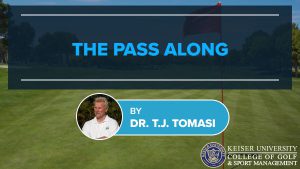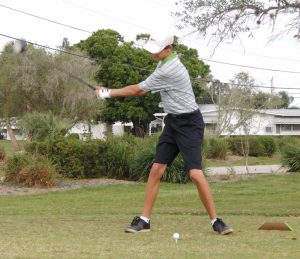The Pass Along

By Dr. T.J. Tomasi, Keiser University College of Golf Senior Faculty and Director of Research
While you may not be consciously aware of it, your brain has no problem keeping track of your club head when it’s in front of you because the club head is “seeable,” either by looking directly at it or through your peripheral vision during the takeaway.

While he doesn’t realize it, to track his clubhead with his eyes, this young player has turned his head much too far, and it’s affecting the quality of his swing.
But during your backswing, as your hands cock, the clubhead leaves your visual field. At this point, your brain must rely solely on your bodily network of sensors to report where your body parts are. The problem is that when you suddenly deprive your brain of its dominant tracking system (sight), it requires a smooth transition from your vision to your kinesthetic system to keep the clubhead going where it should. I call this process the pass-along.
Takeaway: Turning over your swing solely to your sense of feeling is just asking for trouble because “feel” is a shaky edifice on which to build your swing. Complete reliance on unbridled feelings will mislead you every time.

At this point, not even a player this supple can still see the clubhead. To break himself of his head over-turn problem, he should do the drill outlined below.
You can take two steps to keep your good swing around as long as possible. First, make a blueprint of your good swing – videotape it and write down, in detail, what you do at key positions when you are swinging well. If you don’t know what you’re doing, see your teaching pro and write down what they tell you. With your blueprint in hand, you can quickly repair your swing when it starts to go south.
Second, do the following drill any time your swing goes on wobble: Close your eyes, and from your normal address position, swing your clubhead to waist high. Now open your eyes and check how near you came to your goal; then adjust and close your eyes to embed the feel. Repeat this closed-open-adjust-closed sequence with your hands at ten o’clock, both for the backswing and the downswing. This will help you transition from sight to feel without a hitch.
The College of Golf at Keiser University can help. With PGA professionals on staff and state-of-the-practice technology available to our students, we can prepare you for the golf career of your dreams. Contact us today for more information.














